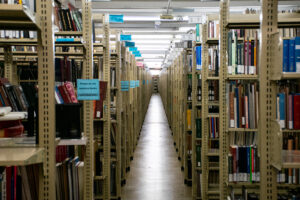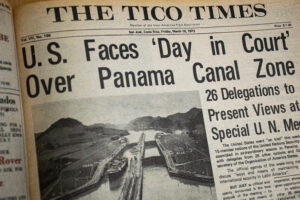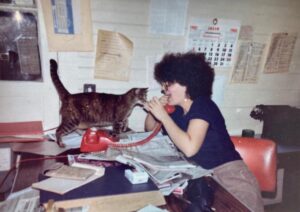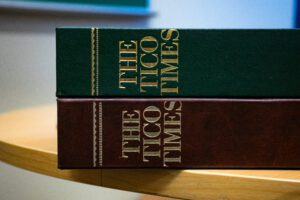During the late 1970s, when Costa Rica’s leading English-language newspaper was covering the various Central America wars, copies of The Tico Times were circulated to readers around the globe, from Afghanistan to Alaska.
Last month, editions of the newspaper once again made a transnational trek, this time to their new home at the Nettie Lee Benson Latin American Collection at the University of Texas at Austin.

The Tico Times, pictured here in 1990, served as a training ground for mainly journalists reporting in English from Central America. (Photo courtesy Lezak Shallat)
The 45 tomos that make up the printed history of the award-winning English-language publication had been lying in the home of late publisher and editor Dery Dyer, who died in September 2020 due to lung cancer. Dyer’s widower, Jim Molloy, was selling the property and wasn’t sure what to do with them.
“I was really wanting to get Dery’s personal set where they could be accessed by people who were interested and I didn’t know where to go,” Molloy told LatAm Journalism Review (LJR).
From 1956 to 2012 – with a brief 12-year break starting in 1960 – The Tico Times published a weekly newspaper and served as a training ground for those who had either stumbled upon its headquarters in San José, Costa Rica, or who had sought it out as an entrypoint to reporting on Latin America.
One of those journalists was Lezak Shallat. About a year ago, the freelance journalist found herself reminiscing with a friend about a trip to Nicaragua in the late 1970s when she was on assignment for The Tico Times.
Suddenly, a concerning thought crossed her mind.
“I froze and I said, ‘Wait, but where are The Tico Times?’” Shallat, now based in California, told LJR. “At that moment, it occurred to me that no one really knew and that I needed to contact Jim and find out.”
Shallat, who had earned her Master’s degree in Latin American Studies from the University of Texas at Austin, immediately thought of the Benson, one the world’s leading Latin America-related libraries. She decided to reach out to a contact there provided by an old professor.

The Benson Latin American Collection has over 1 million resources dedicated to Latin America and U.S. Latino communities, according to Daniel Arbino, head of collection development at the library. (Hugo Ortiz/Knight Center)
“The Tico Times covered Costa Rica and Central America at a time when the region was immersed in conflict and the subject of international media attention. It broke many important stories, and served as a base for foreign journalists reporting on the region,” Shallat wrote in an email to Daniel Arbino, head of collection development at the Benson.
One year later, the 45 extra-large books that make up the Dyer family’s personal archive of The Tico Times started their journey to Texas, finally arriving in September 2023.
“This is a very unique newspaper for us,” Arbino told LJR while flipping through the heavy volumes currently sitting on a desk in his office, where they also line the shelves and sit on the floor in large gray bins.
From high school project to covering the Central American crises
U.S. expats Elisabeth and Richard Dyer founded The Tico Times in May 1956 after the former was approached by high school students from the international Lincoln School in San José who wanted to learn about journalism. Elisabeth Dyer had worked for the New York Post and Hearst publications, and her husband for the Associated Press and International News Service.
The newspaper temporarily stopped printing in 1960 when the Dyers moved to Chile. After Elisabeth’s death, Richard Dyer and his daughter Dery returned to Costa Rica in 1971, and printing resumed in February 1972 with Dery as editor.

Eduardo Ulibarri, former director of Costa Rican newspaper La Nación, said The Tico Times was independent and critical of U.S. policies. (Hugo Ortiz/Knight Center)
“During the time of crisis in Central America, when the ideological confrontation was at its peak, the contras in Nicaragua, the support of Ronald Reagan's government for the contras, they always maintained a very independent and critical position of the policies of the United States government,” Eduardo Ulibarri, former director of Costa Rican newspaper La Nación, told AmeliaRueda.com upon Dery Dyer’s death.
One example is the newspaper’s reporting on the discovery of an airstrip used by the contras, Nicaraguan counterrevolutionaries who were supported by the U.S. government.
The crisis tragically touched the newspaper in 1984 when one of its reporters, Linda Frazier, was killed in a bombing at a press conference held by guerrilla leader Edén Pastora in Nicaragua.
Subsequently, journalists at the newspaper also covered the Central American Peace Accords in the late 1980s.

Lezak Shallat plays with The Tico Times' cat, Beanbag, at the newspaper's offices in 1981. (Photo courtesy Lezak Shallat)
“The Tico Times had a unique view of events in Costa Rica and in Central America because we were able to cover things on a week-to-week basis and go into a certain depth,” John McPhaul, a veteran of The Tico Times, told LJR. “The whole peace initiative of [former Costa Rican President Óscar] Arias was a process, and The Tico Times was able to cover it in-depth.”
After Arias won the Nobel Prize in 1987, McPhaul said, people from around the world started looking to The Tico Times for information about potentially settling or investing in Costa Rica. When he joined the paper in 1980, he said, the audience had been mainly Costa Rican leaders and the local expatriate community, as well as journalists from local papers.
As eco-tourism grew in Costa Rica, that, too, became a beat for the journalists. They also covered deforestation and efforts to re-forest affected areas.
“In the 2000s, the newspaper became an important source of information for the growing U.S. and European expatriate community,” McPhaul noted in a moving 2020 tribute to Dery Dyer, who became publisher in 1996 after her father died.
A legacy
In 2006, 50 years after it was first founded, Dery Dyer reflected on the legacy of the newspaper.
"On the one hand, we have tried to explain what Costa Rica is and its idiosyncrasies to readers who know the country. On the other hand, we tried to bring ideas that are not familiar in the country. For example, for many years we have insisted on the issue of caring for the environment," Dery Dyer told newspaper La Nación.
At the time, The Tico Times had more than 60 employees and a circulation of 15,000. It also had a small English-language newspaper in Nicaragua, “The Nica Times.”
But, the business model crisis that claimed the lives of many print publications around the world also arrived in Costa Rica. The Tico Times ended its print edition in 2012 after experiencing large losses in advertising. The online publication, following many changes in ownership, still exists today.

Printed from 1956 to 2012, The Tico Times covered Central America for an English-speaking audience in Costa Rica and abroad. (Hugo Ortiz/Knight Center)
Among the newspaper’s legacies is its role in working to end mandatory licensing of journalists.
In 1983, a journalist for the Tico Times, Stephen Schmidt, received a three-month suspended jail term for practicing journalism without a license. All journalists working in Costa Rica were required to be licensed with the Colegio de Periodistas, the national journalists’ association.
In a 1985 advisory opinion, the Inter American Court of Human Rights rejected the State’s arguments for compulsory licensing in what “has become the prevailing standard on this issue in the inter-American System,” according to the Organization of American States.
The Costa Rican Supreme Court finally overturned the licensing law in 1995. That same year, Richard Dyer was given the Grand Prize for Press Freedom by the Inter American Press Association (IAPA) for his fight against the licensing requirement.

The Tico Times archive will be available to the public to access from the Rare Books Reading Room at the Benson. (Hugo Ortiz/Knight Center)
The Tico Times was also recognized by other awards in the region, including the prestigious Maria Moors Cabot Prize from Columbia University, which Richard and Dery Dyer received in 1985.
The newspaper also earned praise from colleagues at competing publications.
A 1979 Associated Press article – often cited by alumni of the paper – quoted La Nación publisher Guido Fernández as saying The Tico Times “introduced professionalism into Costa Rican journalism” and “led the way in investigative reporting.”
The journalists who worked under the Dyers are also part of the legacy of The Tico Times.
“[Dery Dyer] was very proud of the fact that a lot of Tico Times’ journalists went on to bigger and more important journalistic jobs and a lot of them attributed getting their start and learning journalism through Dery and their time at The Tico Times,” Molloy said.
Now that The Tico Times archives are in Austin, once they are cataloged they will be publicly available in the Rare Books Reading Room. Shallat said she and her former colleagues are planning a trip to flip through the pages and find old clippings.
Molloy expressed his gratitude to the former Tico Times journalist for her work making sure the print editions found a safe haven.
As far as how Dery Dyer would feel, “I think she’d be delighted,” he said.